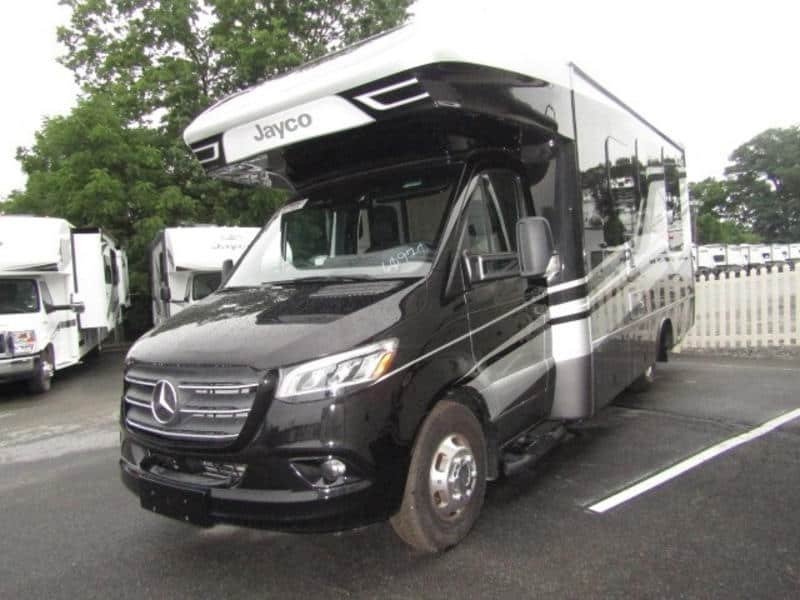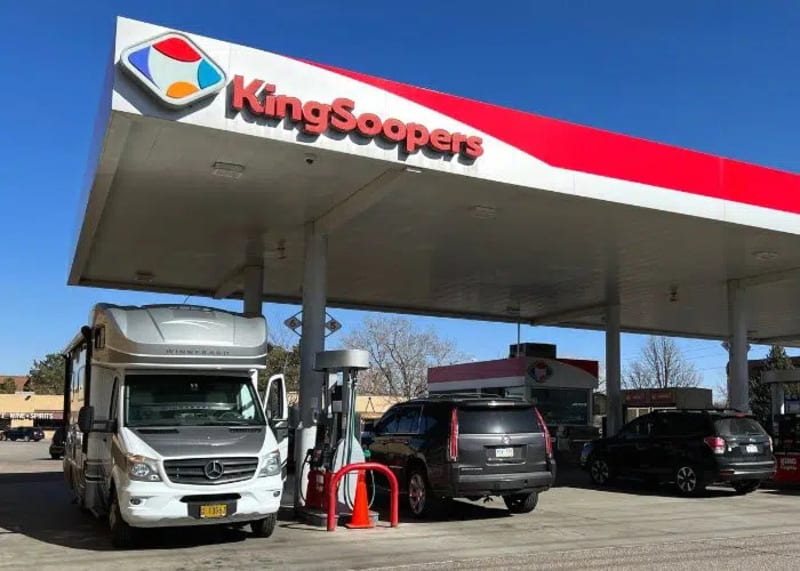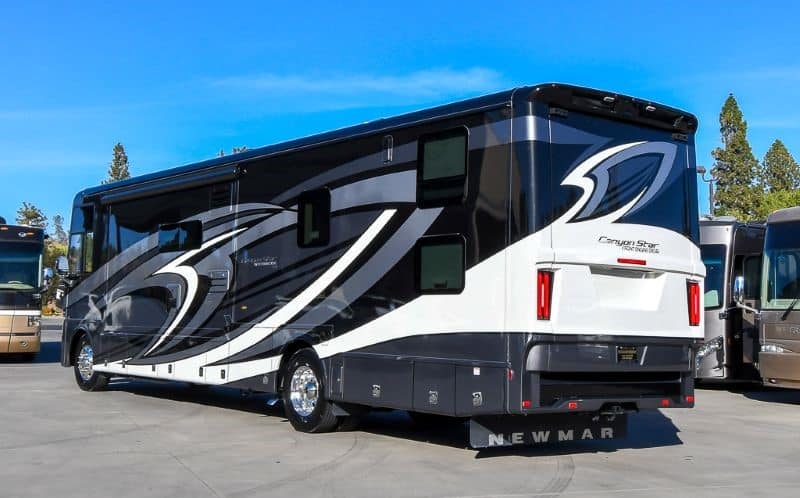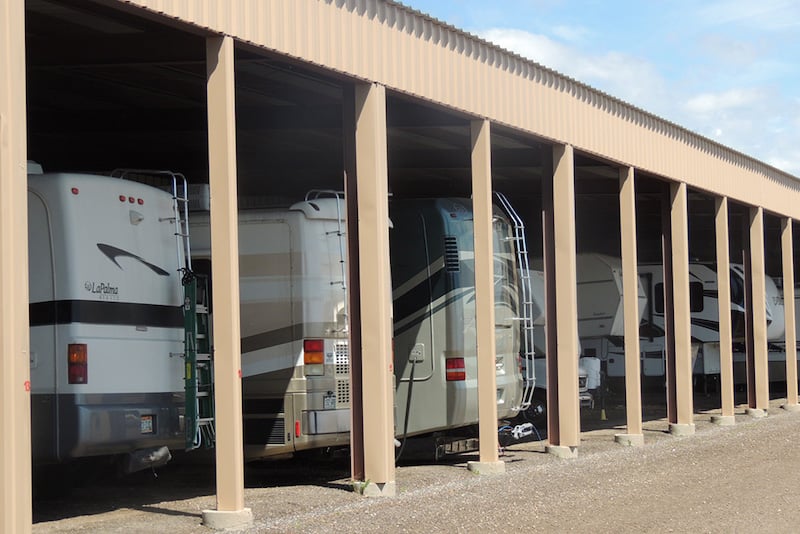Updated January 27, 2024
Unpredictable and ever-changing fuel prices may have you wondering which Class C RVs get the best gas mileage. While some fuel-saving tips and tricks apply to any RV, miles per gallon (mpg) still vary greatly across the industry.
It’s important to choose an RV based on a variety of factors. For the most fuel-efficient rigs on the market, look to compact Class C models with diesel engines and low gross vehicle weight ratings.
We’ve compiled a list of Class C RV gas mileage standouts. Check out these efficient motorhomes and our tips and tricks for keeping fuel expenses low.
Are Class C RVs Considered Fuel Efficient?
Class C RV gas mileage is usually better than the gas mileage you can expect with Class A RVs. In particular, the Euro-styled Class Cs, built on the Dodge RAM ProMaster, Mercedes-Benz Sprinter, or the Ford Transit Chassis.
The reason for this is that larger rigs are heavier and require engines that produce higher horsepower and torque to move them.
8 Class C RVs with Decent Gas Mileage
1. Coachmen Prism Select 24FS
Our Pros and Cons
✅ The bathroom is easily accessible when the slide is pulled in.
⛔ The pots and pans drawer catches on the bedroom step hardware.
- Engine: Mercedes-Benz Turbo Diesel
- 3.0L V6 BlueTec Turbo OR
- 2.0L I4 OM654 Twin Turbo
- Avg Gas Mileage: 14-16 mpg
- Chassis: MB Sprinter 3500
- Length: 24.11 ft.
- GVWR: 11,030 lbs.
- Tow Capacity: 5,000 lbs.
- Sleep: 4-6
The Coachmen Prism Select 24FS is a lightweight Class C RV with great gas mileage and a superior floor plan.
The Prism’s innovative upper pantry hides the TV that faces the living room area. The lower half boasts room for various ingredients and offers a new take on the kitchen work triangle.
Opposite the pantry are the three-burner stovetop and the oven. The kitchen amenities are some of the best you’ll find in a small, fuel-efficient Class C Motorhome.
Other elective upgrades include hydraulic leveling jacks and electric stabilizer jacks. Prism Elite models offer even more choices, including an armless awning, running boards, and an electronic step.
Factors That Affect Gas Mileage:
Each of these upgrades adds additional weight to the rig. Although it may seem negligible, the heavier an RV is, the worse its fuel economy will be.
2. Dynamax Isata 3 24RW
Our Pros and Cons
✅ Placing the bathroom sink outside the bathroom adds functionality and space.
⛔ If you choose the 3-seat sofa, you’ll need to bring your own folding table.
- Engine: Mercedes-Benz Turbo Diesel
- 3.0L V6 BlueTec Turbo OR
- 2.0L I4 OM654 Twin Turbo
- Avg Gas Mileage: 13 -18mpg
- Chassis: MB Sprinter 3500
- Length: 24.7 ft.
- GVWR: 11,030 lbs.
- Tow Capacity: 5,000 lbs.
- Sleep: 2-6
As far as fuel-efficient Class C RVs go, the Dynamax Isata 3 24RW is one of the best for families. With the ability to sleep six, this RV has more beds than other campers its size.
Another uncommon aspect of this floorplan is the separation of the bathroom vanity from the toilet and shower. This bathroom setup is another great family-friendly feature, allowing two people to get ready simultaneously.
Dynamax allows you a dinette, a 3-seat sofa with power recliners on each end, or theater seats in the road side slideout. Families may prefer the sofa, while couples might favor the theater seats.
Factors That Affect Gas Mileage:
When customizing the floorplan in your new Dynamax Isata, keep in mind the weight of the Class C and gas mileage go hand in hand.
You’ll have a choice of a cab-over bunk or a B plus overhead cap with cabinets and an entertainment center. If you choose the B plus cap, you lose the overhead loft sleeping space, but you make your Compact Class C more aerodynamic, which helps with mpg.
3. Entegra Qwest 24T
Our Pros and Cons
✅ Dual twin with a king conversion add storage and are pet approved!
⛔ Make sure you can live with very little counter space.
- Engine: Mercedes-Benz Turbo Diesel
- 3.0L V6 BlueTec Turbo OR
- 2.0L I4 OM654 Twin Turbo
- Avg Gas Mileage: 12-15 mpg
- Chassis: MB Sprinter 3500
- Length: 25.2 ft.
- GVWR: 11,030 lbs.
- Tow Capacity: 5,000 lbs.
- Sleep: 2-4
If you’re looking for a unique floor plan with tons of storage, look no further than the Entegra Qwest 24T. The rear bedroom with twin bunks has become a highly sought-after floorplan. The ability to convert from two bunks to a king bed offers flexible sleeping arrangements for every type of trip.
Not only that, but the versatile bedroom layout means that you have access to overhead cabinets on all three walls. With more storage than most other RVs, this unique configuration lends itself well to yours, mine, and our organized gear.
You’ll also find abundant storage throughout the rest of this RV. The under-sofa drawers are quickly and conveniently accessed. In addition, there’s a large wardrobe just outside the bedroom area and two additional overhead cabinets in the main living space.
Factors That Affect Gas Mileage:
There aren’t as many variables impacting gas mileage in this Class C RV as there are in others. Still, opting for the overhead bunk instead of open space could impact gas mileage because it’ll add weight and decrease aerodynamics.
4. Forest River Forester MBS 2401T
Our Pros and Cons
✅ You can keep the loft or choose the B+ nose cap with an entertainment center.
⛔ Watch out when entering, so you don’t hit yourself on the flip-up countertop.
- Engine: Mercedes-Benz Turbo Diesel
- 3.0L V6 BlueTec Turbo OR
- 2.0L I4 OM654 Twin Turbo
- Avg Gas Mileage: 14-16 mpg
- Chassis: MB Sprinter 3500
- Length: 25.5 ft.
- GVWR: 11,030 lbs.
- Tow Capacity: 4,200 lbs.
- Sleep: 2-4
The Forest River Forester MBS2401T has a luxurious feel while remaining one of the best Class C RVs for gas mileage.
Immediately you’ll notice how beautiful decor of this Class C Motorhome. The seamless marble-like countertop, stainless steel convection microwave, and 10 cubic foot refrigerator make the kitchen feel both high-end and inviting.
The herringbone floor design is also unusually luxurious for a Class C camper at this price point. It flows seamlessly throughout the camper, even into the spacious rear bathroom. Every inch of this motorhome has a flawless aesthetic.
Factors That Affect Gas Mileage:
Undoubtedly, the Forester MBS2401T comes with more options than many similarly sized Class C RVs.
As you make your choices, you’ll want to remember that some upgrades, like the theater seats and overhead entertainment center, can alter fuel efficiency because of the weight alteration.
5. Jayco Melbourne Prestige 24NP

Our Pros and Cons
✅ The two living room spaces give owners space to themselves.
⛔ The water closet suffered interior space to max out the rear living room.
- Engine: Mercedes-Benz Turbo Diesel
- 3.0L V6 BlueTec Turbo OR
- 2.0L I4 OM654 Twin Turbo
- Avg Gas Mileage: 12-15 mpg
- Chassis: MB Sprinter 3500
- Length: 25.2 ft.
- GVWR: 11,030 lbs.
- Tow Capacity: 5,000 lbs.
- Sleep: 2-5
The new 24NP floor plan offered in the Jayco Melbourne Prestige gives owners two separate daytime living spaces. The L-shaped sofa that folds down into a murphy bed makes the interior of the coach feel open and spacious. The L-shaped kitchen counter does the same.
The pass-through bathroom is also a really nice feature. Separating the toilet and shower is convenient but still surprisingly uncommon. The proximity of the restroom to the front door and lack of slide-out also make quick pit stops a breeze. This new floorplan is sure to be a favorite for tailgating and boondocking alike.
The front living space has a multifunctional two-seater dinette behind the cab. The two seats become a dinette with a pedestal table or convert into a twin bed at night.
Factors That Affect Gas Mileage:
No slideout means this Class C RV gets better gas mileage. Slideouts add significant weight, so not having one benefits the mpg.
While the GVWRs of most of the campers on our list are very similar, that doesn’t mean that the carrying capacity is necessarily the same.
The Unloaded Vehicle Weight (UVW or dry weight) can vary quite a bit. The Jayco Melbourne Prestige has enough to accommodate a comfortable camper who leans a little towards the glamping side. Yet, if you’re headed on a multi-day trip, you may want to sacrifice cargo weight to get those extra miles.
6. Thor Delano 24RW
Our Pros and Cons
✅ The expandable north/south rear bed solves the cramped bedroom issue!
⛔ The microwave is high up on the wall.
- Engine: Mercedes-Benz Turbo Diesel
- 3.0L V6 BlueTec Turbo OR
- 2.0L I4 OM654 Twin Turbo
- Avg Gas Mileage: 10-12 mpg
- Chassis: MB Sprinter 3500
- Length: 25.8 ft.
- GVWR: 11,030 lbs.
- Tow Capacity: 5,000 lbs.
- Sleep: 2-5
Bright and airy is the theme of the Thor Delano 24 RW. This Class C Motorhome with great gas mileage also enjoys tons of natural light. The skylight over the kitchen illuminates the countertop, while the bathroom skylight adds both light and headroom to the shower.
The rear bedroom doesn’t disappoint, either. The slideout, three large windows, and mirrored closet doors work together to open up the space.
If you like the feel of the bedroom, you’ll love the expansive skylight in the cab over the bunk. The Thor Delano makes it easy to forget there’s any barrier at all between you and the great outdoors.
Factors That Affect Gas Mileage:
The Delano 24RW has not one but two slideouts. As far as gas mileage in this Class C RV goes, this can be a disadvantage because of the greater UVW.
You may have to pack lighter to keep your fuel economy on par with other small Class C RVs. Even with lighter cargo, this RV may never get the gas mileage of other small Class C RVs.
But it’s important to remember that even if you have to max out your carrying capacity, this RV will still get better mpg than many other motorhomes on the market.
7. Tiffin Wayfarer 25JW
Our Pros and Cons
✅ It’s incredible how Tiffin fits a multi-purpose desk and washer/dryer in this coach!
⛔ The combo washer/dryer eats up much storage space.
- Engine: Mercedes-Benz Turbo Diesel
- 3.0L V6 BlueTec Turbo OR
- 2.0L I4 OM654 Twin Turbo
- Avg Gas Mileage: 12-15 mpg
- Chassis: MB Sprinter 3500
- Length: 24.8 ft.
- GVWR: 11,030 lbs.
- Tow Capacity: 5,000 lbs.
- Sleep: 2-4
The Tiffin Wayfarer 25JW’s unique layout offers many amenities in a compact floor plan. The dual-purpose queen-size Murphy bed/sofa frees up living room space in seconds. Another less common, but perhaps even more sought-after, dual-purpose furniture piece is the entertainment center/desk combo.
The Tiffin Wayfarer 25JW also has a very large rear bathroom. Spanning the entire width of the camper, this bathroom is spacious and full of light.
You’ll also appreciate the ample counter space in both the bathroom and kitchen. With so much room and flexibility, it’s easy to forget that the Tiffin Wayfarer 25JW is a fuel-efficient Class C RV under 25ft in length.
Factors That Affect Gas Mileage:
One feature of the Tiffin Wayfarer 25JW that we’ve yet to mention is the optional washer/dryer combo. On our list of Class C RVs with the best gas mileage, the Wayfarer is the only one that offers this amenity.
Washers and dryers undoubtedly add additional weight to the coach, thereby slightly reducing the motorhome’s mpg.
Still, with the office space, large bathroom, spacious living area, and washer/dryer combo, this motorhome is a favorite of full-time RVers. If you’re a full-timer who remains stationary for long periods of time, the benefits of an onboard washer/dryer almost certainly outweigh the additional costs of a slightly lower mpg.
8. Winnebago View 24D
Our Pros and Cons
✅ You’ll find a wide center aisle on this floorplan.
⛔ Similar floorplans offer a TV for the front and another for the murphy bed.
- Engine: Mercedes-Benz Turbo Diesel
- 3.0L V6 BlueTec Turbo OR
- 2.0L I4 OM654 Twin Turbo
- Avg Gas Mileage: 16-18 mpg
- Chassis: MB Sprinter 3500
- Length: 25.6 ft.
- GVWR: 11,030 lbs.
- Tow Capacity: 5,000 lbs.
- Sleep: 2-4
With one of the largest slideouts of any small Class C RV, the Winnebago View 24D has space for everything. The Murphy bed’s ability to fold up while not in use contributes to the open feel. Another great use of space is the large full-width bathroom in the coach’s rear.
You can customize the floor plan by choosing between the theater seating with swivel tables or a U-shaped dinette in the front portion of the road side slideout.
The movable pedestal table positioned in front of the sofa or between the captain’s chairs allows even more flexibility.
Factors That Affect Gas Mileage:
The large slideout and optional theater seating will impact gas mileage. These heavier features will simultaneously decrease your cargo-carrying capacity and fuel efficiency. But this slight decrease in gas mileage is a small price to pay for the amenities and flexibility offered.
Do Class C RVs Get Better Gas Mileage Than Class A RVs?
Class C RV gas mileage is generally better than that of Class A RVs. This only makes sense once you realize that larger rigs are heavier and consume more fuel. The chart below breaks down the mpg that you can expect from each type of drivable RV.
| Low MPG | High MPG | |
| Class A Diesel | 7 | 12 |
| Class A Gasser | 6 | 10 |
| Super C Diesel | 8 | 12 |
| Ford E-Series/Chevy Express Standard Class C Gas | 8 | 12 |
| Sprinter/Transit/ProMaster Compact Class C Gas | 14 | 18 |
It’s no coincidence that all eight of the Class Cs with the best gas mileage are built on the Mercedes-Benz Sprinter Chassis. As a regular passenger van, the Sprinter gets 21 MPG city and 24 MPG Highway. The specific fuel efficiency of an individual RV depends on several variables.
RV manufacturers don’t always publish specific mpg for each floorplan in their sales literature. Fortunately, we can look to the Department of Energy for insight into how the additional weight of a motorcoach would impact the engine’s gas mileage.
According to the DOE, for every extra 100 pounds of weight, you can expect your vehicle’s mpg to be reduced by about 1%.
It’s important to note that this 1% estimate is something of a worst-case scenario. RV manufacturers partner with auto manufacturers to ensure that all automotive components are adjusted to perform optimally under the additional weight burden of an RV.
Therefore, you may only lose 1-3 MPG due to coach weight on the chassis. This is true whether you drive a Sprinter, Ford E-Series, or Freightliner M2 Front Engine Diesel (FRED).
To learn how to drive your Class C RV to get the best gas mileage check out this article called What is the Average Gas Mileage for a Class C RV?
Which Driveable RV Is Most Fuel Efficient?
Mercedes is taking a step to improve fuel efficiency across its Sprinter product line. Beginning January 2023, they’ll no longer offer the BlueTec V6 diesel engine. Instead, they’ll offer the OM654 Inline 4-cylinder engine with twin turbos.
Going forward, the engine options for Class C motorhomes on Sprinter Chassis will be a 4-cylinder gas engine, a 4-cylinder diesel engine with a single turbo, or a 4-cylinder diesel engine with twin turbos.
Effectively, this will give vehicles built on the Sprinter Chassis the potential for some more horsepower and torque than the diesel V6 engine. The added benefit is that this new engine with twin turbos will retain 4-cylinder fuel efficiency.
Be sure to check out the August 22 edition of RV Camping Magazine for further details on how this will affect the Sprinter’s performance.
Is Gas or Diesel Best for Fuel Efficiency in an RV?
According to the Universal Technical Institute, diesel engines get about 20% better fuel economy than gas engines.
Why, you might ask? It begins with the fact that increased air compression means that diesel engines operate at a higher temperature. As a result, thermal energy is more efficiently converted to mechanical energy.
The increased thermal efficiency accounts for diesel engines’ better fuel economy than their gasoline-powered counterparts.
It’s also important to note that diesel engines operate with much fewer revolutions per minute than gas engines. As an added benefit, diesel engines typically have a longer life.
7 Things That Affect Gas Mileage for Class C RVs
1. Engine Type
Diesel engines run at a higher thermal efficiency than gas engines. As a result, the gas mileage of Class C motorhomes with diesel engines is typically better than similar Class Cs with gasoline-powered engines.
2. Size and Weight
Weight is a big factor in the fuel economy of an RV. For each additional 100 pounds of weight, the DOE estimates that mpg is reduced by 1%. Although RV engines and transmissions are engineered specifically to optimize motorhome gas mileage, heavier rigs and lower mpg still go hand in hand.
Similarly, aerodynamics and wind resistance are factors that impact fuel efficiency. For instance, adding a large satellite or oversized air conditioner can hurt your gas mileage by creating extra resistance.
3. Cargo and Occupancy
Cargo and occupancy of a motorhome also impact its overall weight and, therefore, its fuel economy. The heavier the cargo and the occupants, the less fuel efficient the RV.
It’s also important to mention that towing anything with your RV will tax the engine increasingly. An engine that’s working harder uses more fuel, so your fuel efficiency will always suffer when you tow.
4. Driving Habits

Driving habits also play a huge role in determining Class C RV gas mileage. If you accelerate quickly, speed, travel at an inconsistent rate, or stop and start frequently, you’ll increase the fuel consumption of your RV.
Newer motorhomes now have adaptive cruise control that keeps you spaced correctly from the vehicle in front of you and other smart features. Cruise control can save fuel by keeping your motorhome at a more consistent speed.
5. Destination
Not surprisingly, your destination also plays a role in your Class C RV’s gas mileage. City driving yields worse fuel efficiency than highway driving because of slower speeds and more frequent stops.
Similarly, treacherous terrain, like steep or winding roads, will work the RV engine harder and decrease the vehicle’s mpg.
6. Consider a Fuel Economy Chip
Fuel economy chips work to optimize the performance of your RVs engine. These chips can help you travel 2-3 miles further per gallon by monitoring and adjusting for driving habits and conditions. If gas mileage in your Class C RV is of particular concern to you, consider adding a fuel economy chip.
7. Keep Up with Maintenance
Routine maintenance is vital to optimizing the fuel efficiency of any vehicle, and Class C motorhomes are no different. Little things like a dirty air filter or incorrect tire pressure can reduce your projected MPGs by as much as 10%.
Is It Important to Choose an RV with Better Gas Mileage?

Class C RV gas mileage will be more important to some RVers than others. No one likes spending more at the gas pump than necessary. But how important fuel efficiency is to you depends greatly on how far and often you plan to drive your motorhome.
80% of all RVers camp within 200 miles of their home. A tank of gas or diesel can get you there and maybe partially back. Yet some use their Compact Class C as a daily driver while on their trip since they’re easy to maneuver through traffic.
Those on long, multi-day trips or full-timers must consider that fuel costs can be as much as 50% of their trip budget.
Final Thoughts on Class C RVs with the Best Mileage
Your Class C RV’s gas mileage is important, especially if you travel a lot. Maximizing your miles per gallon will save you money and time. After all, fewer fuel stops mean that you’ll get to your destination sooner.
Class C Motorhomes built on the Mercedes-Benz Sprinter Chassis are some of the most fuel-efficient on the market. Compact yet powerful, these motorhomes are a great choice.
The inline 4-cylinder engine with twin turbos that Mercedes plans to roll out at the beginning of 2023 is an exciting development. This new twin-turbo promises Class Cs the gas mileage of a 4-cylinder with the torque and power of a 6-cylinder.
Even with industry innovations, gas mileage in Class C RVs still depends greatly on the driver. Aggressive driving, treacherous terrain, and stopping and frequently starting all decrease gas mileage.
The rig’s cargo, UVW, and aerodynamics also play a huge role in determining fuel efficiency. Don’t forget you can always add a fuel economy chip to maximize your gas mileage even more.
About the Author:
Laura is a part-time RVer and a full-time mom of three. Long-time campers and RVers before children, Laura, and her husband have fallen even more in love with the RV lifestyle since becoming parents to a child with food allergies.
Having her own kitchen on wheels makes her RV trips amazing. Laura is passionate about finding ways to make traveling with young children fun, easy, and attainable.




